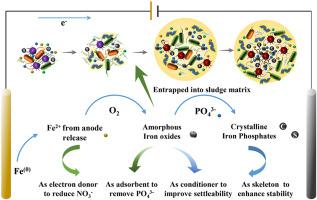Journal of Cleaner Production ( IF 9.7 ) Pub Date : 2021-02-18 , DOI: 10.1016/j.jclepro.2021.126394 Yuan Guo , Zhiqiang Zhang , Wenxin Shi , Bing Zhang , Weiguang Li , Fuyi Cui , Piet N.L. Lens

|
Herein, the effects and mechanisms of the element Fe as mineral forms present in the aerobic granular sludge (AGS) matrix on the reactor performance were systematically investigated in an AGS reactor coupled with iron electrolysis (denoted as Re). As comparison, a control AGS reactor (denoted as Rc) was operated in parallel without an iron electrolysis unit. Results showed that the mineral-rich AGS was rapidly formed in Re, whose specific growth rate of granular diameter reached 0.13 day−1. During the granulation process, the dominating minerals present in Re sludge gradually evolved from amorphous iron oxides to crystalline iron phosphates. In contrast, the formed AGS in Rc was slow-growing and mineral-deficient. Accordingly, the roles of evolution of sludge mineral composition on accelerating granulation process were analyzed and verified. Moreover, Re exhibited higher total nitrogen (TN) and total phosphorus (TP) removal efficiencies, respectively 1.18 and 1.97 fold higher than those of Rc. Mechanisms investigation indicated that the enrichment of the genus Dechloromonas (with relative abundance of 5.45%) in Re sludge could utilize the electrolytic Fe(II) to reduce nitrate for TN removal, and the formation of other iron species contributed to TP removal through initiating various physicochemical reactions with phosphate, including coprecipitation with Fe(III) and adsorption by iron oxides. Overall, this study provides theory guidance and control views for practical applications of Fe-related strategies aiming to enhance operation performance of AGS reactors.
中文翻译:

污泥矿物成分的演变增强了好氧颗粒污泥反应器结合铁电解的运行性能
在本文中,在结合铁电解的AGS反应器中系统地研究了好氧颗粒污泥(AGS)基质中存在的矿物质形式的元素铁对反应器性能的影响和机理。作为比较,对照AGS反应器(表示为Rc)在没有铁电解单元的情况下并行操作。结果表明,富含矿物质的AGS在Re中迅速形成,其粒径的比生长速率达到0.13 day -1。在制粒过程中,Re污泥中存在的主要矿物质逐渐从无定形氧化铁演化为结晶性磷酸铁。相反,Rc中形成的AGS生长缓慢且缺乏矿物质。因此,对污泥矿物组成的演变对加速造粒过程的作用进行了分析和验证。此外,Re表现出更高的总氮(TN)和总磷(TP)去除效率,分别比Rc高1.18倍和1.97倍。机理研究表明,Dechloromonas属的富集(相对含量为5.45%)的Re污泥可利用电解Fe(II)还原硝酸盐以去除TN,而其他铁物种的形成则通过引发与磷酸盐的各种物理化学反应,包括与Fe(的共沉淀)来促进TP的去除。 III)和被氧化铁吸附。总体而言,本研究为旨在提高AGS反应堆运行性能的铁相关策略的实际应用提供了理论指导和控制观点。











































 京公网安备 11010802027423号
京公网安备 11010802027423号